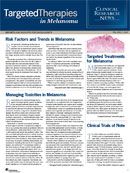Risk Factors and Trends in Melanoma
Risk factors for contracting melanoma are complex and can include environmental exposure and an individual’s genetic susceptibility, but people at highest risk are those with a personal or family history of melanoma and those with large, atypical, and/or multiple (more than 50) nevi.
Risk factors for contracting melanoma are complex and can include environmental exposure and an individual’s genetic susceptibility,1,2but people at highest risk are those with a personal or family history of melanoma and those with large, atypical, and/or multiple (more than 50) nevi.
“The people at greatest risk to develop melanoma epidemiologically are those with fair skin, light or red hair, light eyes, and extensive history of sun exposure or previous sunburn,” said Christopher J. Miller, MD, director of dermatologic surgery at the Hospital of the University of Pennsylvania. “All of these people should be monitored very closely,” he cautioned.
Other risk factors include a tendency to freckle, sun sensitivity, use of tanning booths, and immunosuppression. The genetic susceptibility and environmental exposure risks are most prominently illustrated in individuals with fair skin and light eyes; however, melanoma can occur in any ethnic group and in areas of the body that have not had substantial sun exposure.1,2
Individuals with few nevi tend to develop melanoma on areas of the body that are repeatedly exposed to sun, while individuals with large numbers of nevi have an increased risk of melanoma where nevi tend to be present, regardless of sun exposure (eg, the back).2
According to Miller, both total cumulative ultraviolet (UV) exposure and intensity of individual exposures play a role in etiology and subtype of melanoma.
“Intermittent, intensive sun exposure is a significant risk factor to develop the most common type of melanoma, called superficial spreading melanoma,” Miller said. This type of melanoma is typically found on areas of the body that do not receive constant and continued UV exposure (eg, the trunk). “There is another subtype of melanoma called a lentigo maligna melanoma that occurs more commonly on the head and neck or on the dorsal hands and forearmsareas that are more commonly exposed to regular, cumulative sun exposure,” Miller explained.
The increasing incidence of melanoma appears consistent throughout the world, but varies when comparisons in latitude are noted. Melanoma is very rare in Africa, whereas Australia has among the highest incidence rates of melanoma worldwide.3
Approximately 76,100 new cases of melanoma will be diagnosed in the United States in 2014.2Although melanoma accounts for less than 2% of skin cancer cases, it is responsible for most skin cancer deaths. An estimated 9710 persons will die from melanoma in 2014.2
The median age at diagnosis of melanoma is 59 years.1Although the risk of melanoma increases with age, it is one of the most common cancers diagnosed in young adults, particularly young females.1,2 Melanoma is slightly more common in men than in women (1.2:1). Incidence of melanoma is higher in women before the age of 45 years, but rates in men are more than double and triple those in women by (“Risk Factors and Trends” continued) the ages of 60 and 80 years, respectively.1,2
The incidence of melanoma also varies by race; it is approximately 20-fold higher among whites than among African Americans. Incidence rates of melanoma among whites increased by 2.7% per year from 2006 to 2010. Melanoma is rare in African Americans, with a lifetime risk of 0.1%, compared with a lifetime risk of 2.4% among whites. Whites also have a significantly higher incidence compared with Asians and Hispanics. Although incidence of melanoma is lower in the Hispanic and black populations, these groups are more likely to have metastatic disease and poorer outcomes.1,2
The clinical outcome of melanoma initially depends on stage at diagnosis. About 82% to 85% of patients with melanoma present with localized disease, 10% to 13% present with regional disease, and the remaining 2% to 5% have distant metastatic disease at the time of diagnosis.1,2
The 5-year relative survival rate for melanoma, regardless of stage at diagnosis, is 91%. When diagnosed at a local stage, the survival rate is 98%; but metastasis beyond the local site is associated with significantly reduced relative survival (62% and 16% for regional and distant metastases, respectively).1,2Five-year survival rates for melanoma have increased from 82% in the mid-1970s to 88% during the late 1980s and to 93% in 2009. However, survival rates remain substantially lower for African Americans, despite an increase in survival from 57% several decades ago to 77% in 2009 in this population.2
Trends in mortality from melanoma are associated with age. In recent years, death rates from melanoma have been rapidly declining in whites younger than 50 years; however, among whites 50 years and older, melanoma death rates increased by 1.1% per year in men and 0.2% per year in women during the same period.1,2
References
- National Comprehensive Cancer Network. Melanoma (Version 3.2014). http://www.nccn.org/professionals/physician_ gls/pdf/melanoma.pdf. Accessed February 20, 2014.
- American Cancer Society. Cancer Facts & Figures 2014. http:// www.cancer.org/acs/groups/content/@research/documents/ document/acspc-041770.pdf. Accessed February 20, 2014.
- Erdei E, Torres SM. A new understanding in the epidemiology of melanoma.Expert Rev Anticancer Ther. 2010;10(11): 1811-1823.
Survivorship Care Promotes Evidence-Based Approaches for Quality of Life and Beyond
March 21st 2025Frank J. Penedo, PhD, explains the challenges of survivorship care for patients with cancer and how he implements programs to support patients’ emotional, physical, and practical needs.
Read More
